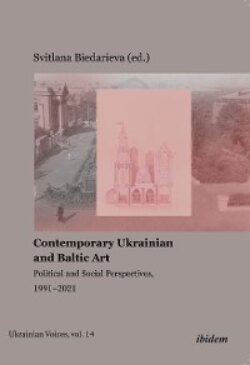Читать книгу Contemporary Ukrainian and Baltic Art - Группа авторов - Страница 13
На сайте Литреса книга снята с продажи.
Everything Was Forever Until It Was No More
ОглавлениеThe 1st Riga Biennial (2018) borrowing its title from cultural historian Alexei Yurchak’s book Everything Was Forever Until It Was No More (2006), positioned itself as a European biennial with a regional focus. That is, along with globally circulating artists it also spotlighted artists from the Baltic and Nordic regions,15 and thus mapped Baltic-Nordic-post-Soviet dynamics. Commenting on this, its chief curator, Katerina Gregos, still referred to the Baltics as “a terra incognita” and a “periphery with a striking history” that is “symbolic of different pushes and pulls, conflicts and paradoxes, and fundamental changes” (Gratza 2018) and to which events like biennales offer international visibility. The biennial was indeed the most ambitious art event in the region in many years, but it continued to apply a rooted hegemonic viewpoint about bringing attention to the margins and ascribed to it the secondary status that postsocialist countries have been facing since the 1990s, when they started to attract the interest of the West as unexplored and exotic places.
The biennial focused on a broad variety of issues related to change, starting from the “great acceleration” and including transformations of social life, the impact of rapid advancements in science and technology, and the negotiation of constant crises—of ecology, capitalism, and democracy. (Gregos 2018, 27-28) Thus, the exhibition sought to cover the broadest thematic horizon of contemporary art and, as an essential part of that, to draw attention to the post-Soviet context. In the thematic structure of the event, the section focusing on the imprints of the past mapped the Baltics as “a region that has experienced successive, traumatic, systemic and often violent changes, shifting from one political ideology to another, from one economy to another, from one ethnic dominance to another.” (Gratza 2018) The artworks formed kaleidoscopic dialogues between the present and the past, and focused on various aspects of its legacy—unspeakable traumas related to Stalinist deportations, the dramatic experiences of World War II refugees, the history of the KGB and censorship, isolation from the rest of the world, rare contact with the West permitted and later forbidden in the official culture, and the civic activism and non-violent resistance of the so-called Singing Revolution at the end of the Cold War, briefly coming under the global spotlight with the collapse of the USSR, among other factors. The artists also reflected on the symptomatic changes in post-Soviet society in the transition from communism to capitalism, construction of new identities, and, finally, the growing gap between the past and the present.
Commenting on the complexity of this past and its implication in contemporary reality, the biennial works connected the postsocialist condition with the postcolonial one, unfolding the peculiar context of local histories. It was clearly employing the abovementioned tactics of contextualization, yet it remained schematic—artworks became local informants for the biennial-as-global-agent, in relation to which this peculiar context maintained the “inerasable sense of difference.” (Tlostanova 2017, 3) With promises to “bring Baltic art out of the shadows” (Kukota 2018; Brown 2018) and to transform its scene into a new “center,” the 1st Riga Biennial continued to reproduce the logic of center−periphery that reinforces the presentation of peripheries as alienated and misunderstood. As humanities scholar Béatrice Joyeux-Prunel argues, the celebration of difference does not necessarily open spaces of inclusion and recognition, but it might be an unconscious investment in the periphery as a desire-production machine. (Joyeux-Prunel 2014, 7)
I will illustrate this argument with a few works included in the exhibition. The title of the 2018 work Es mācēju danci vest (I know how to dance) by Ieva Epnere referred to a well-known Latvian stage folk dance and sought to contextualize the phenomena of folk song and dance culture in Latvia. In the video, the dance was performed in different formats: first, as a concert with dancers in authentic folk costumes, accompanied by singing; then, without music and other attributes, focusing on the emotional portraits of the dancers; and finally, with only one pair of dancers performing a choreography that consisted of certain elements. The work, as the artist explained, was an attempt to deconstruct stage folk dance vocabulary to its basic elements that express the essence or the archaic layer of dance, covered by other layerings of different times, cultures, and ideologies, including patriotic and romantic national values from the beginning of the twentieth century, the aesthetics of Russian classical ballet, the ideology of the authoritarian regime, Soviet mass culture, the reconstruction of the national myth after independence, and so on. Thus, the work also indirectly commented on the hybridity of colonial cultures and nationalism, or how the construction of the national myth is based on inseparably entangled layers of a variety of cultures. “What content do we see in it today?” asked the artist at the end of her work.
The relationship between ecology, posthumanism, and humans and nature was an important context for the work Pickled Long Cucumbers (2017) by Katrīna Neiburga. Playing, or rather reversing the reference to a popular culinary tradition in Latvia in the title of her work, the artist merged personal “mythologies” with a playfully critical vision of survival in nature. In this video, a somewhat psychedelic visual poem, an Adam-and-Eve-like couple—the artist herself and her husband with their four-year-old son—performed various irrational activities in forests and brush and swamp lands. Reading the work both as a longing to return to the “natural” world, far away from urban rush and stress, and as an “ecological fairy tale,” its interpretation was dominated by references to contemporary paganism as characteristic of human relations with nature in Latvia and the Baltics, as well as savagery of their nature. Thus, it became another motif of otherness relevant to the region—although this is one of the myths of constructing eco-nationalism that has developed over a longer period of time.
